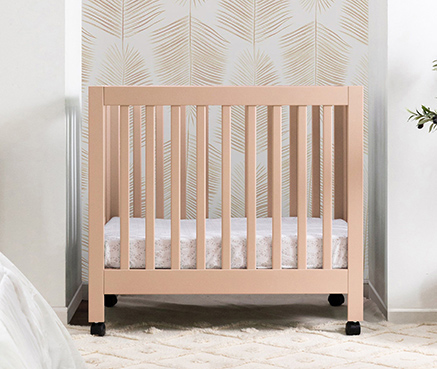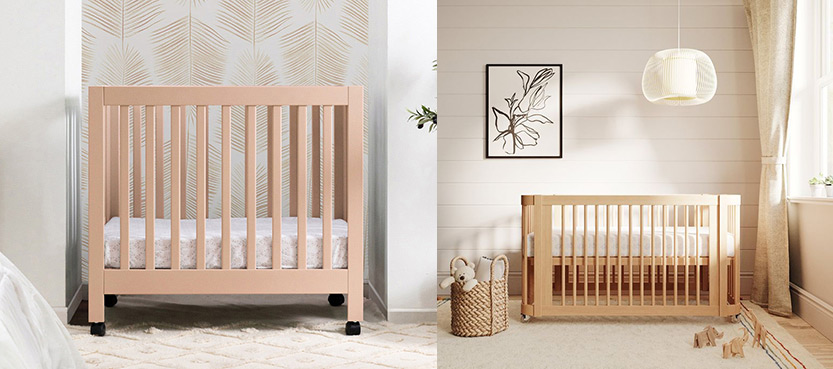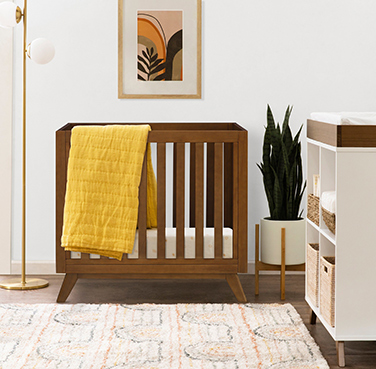When it comes to creating a safe and comfortable sleeping environment for your little one, choosing the right crib is of utmost importance. In this article, we will explore the differences between mini cribs and standard cribs, helping you make an informed decision that guarantees your baby's good sleep.

source: Pinterest
A Mini crib, also known as a portable or compact crib, are smaller versions of standard cribs ideal for limited spaces or travel. They offer a safe and comfortable sleeping area for infants and young children. Mini cribs are generally smaller than standard cribs, measuring around 24 inches wide and 38 inches long. They are suitable for infants and toddlers up to approximately 1-2 years old or until they begin climbing out, at which point transitioning to a larger bed is recommended for safety and comfort.

source: Pinterest
A standard crib is the traditional and most common choice for many parents. These cribs are larger in size compared to mini cribs and provide a spacious sleeping area for infants.
The standard crib size is usually around 28" x 52” (71 cm x 132 cm).
Standard cribs often come with adjustable mattress heights, allowing you to lower the mattress as the child becomes more mobile.

The most obvious difference between regular cribs and mini cribs is their size. Regular cribs typically have standard dimensions of approximately 28 inches wide and 52 inches long, while mini cribs are significantly smaller, around 24 inches wide and 38 inches long. The smaller size of mini cribs makes them suitable for smaller nurseries or for families who prefer a more compact option.
Mini cribs are lightweight and easy to move, making them ideal for families who frequently travel or need a crib that can be easily relocated within their home.
Mini cribs are a practical choice for smaller spaces, allowing you to maximize the available square footage without compromising on safety and comfort.
Standard cribs are typically designed to be used from infancy to toddlerhood and sometimes even beyond with the use of conversion kits. Mini cribs, on the other hand, are more suitable for younger babies and may be outgrown more quickly.
Both regular cribs and mini cribs require specific mattresses that fit their respective sizes. It is crucial to select a high-quality crib mattress that provides optimal support and meets safety standards. Ensure that the mattress fits snugly within the crib, leaving no gaps where your baby could become trapped.

source: Pinterest
Perfect for small spaces or travel: Mini cribs are an excellent solution for families with limited living space or those frequently on the move.
Portability: Their compact size and lighter weight make mini cribs easy to move around the house or take on trips.
Cost-effective: Mini cribs are often more affordable compared to standard cribs, making them a budget-friendly option.
Limited longevity: Due to their smaller size, mini cribs may be outgrown by your baby sooner than a standard crib.
Limited design options: Mini cribs may have fewer design choices available compared to standard cribs.

source: Pinterest
Longevity: Standard cribs can be used for a more extended period, often accommodating your child until they transition to a toddler bed.
Wider range of design options: Standard cribs offer a vast selection of designs, styles, and finishes, allowing you to find the perfect match for your nursery decor.
Convertibility: Many standard cribs can be converted into toddler beds, daybeds, or even full-size beds with the use of conversion kits.
Space requirements: Standard cribs occupy more floor space, which may pose a challenge in smaller nurseries or apartments.
Less portable: The larger size and weight of standard cribs make them less convenient for families who frequently travel.
Choosing between a mini crib and a standard crib depends on your specific needs and circumstances. If space is limited or you require a portable solution, a mini crib may be the ideal choice. On the other hand, if longevity and versatility are important to you, a standard crib with conversion options may be the better option. Remember to prioritize safety and comfort when making your decision, ensuring your baby enjoys a peaceful and secure sleep environment.
Q: Can I use a standard crib in a small nursery?
A: Yes, you can use a standard crib in a small nursery if space permits. However, it's important to measure the available space accurately to ensure that the crib fits comfortably without making the room feel cramped. Consider choosing a more compact design or opting for a mini crib if space is a significant constraint.
Q: Do standard cribs come with a mattress?
A: Typically, standard cribs do not include a mattress. It is recommended to purchase a separate crib mattress for safety and comfort.
Q: Are mini cribs more suitable for travel purposes?
A: Yes, mini cribs are highly portable and lightweight, making them convenient for travel purposes. They are designed to be easily disassembled and transported.